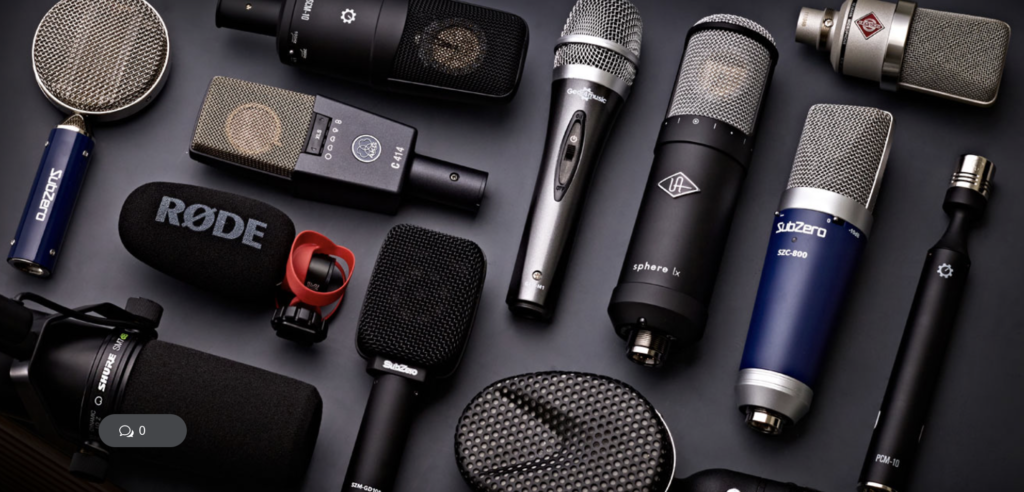Microphones come in various types, each suited for specific applications based on their design and functionality. Below is an overview of the different types of microphones and their common uses or head to Audio-tecnica for an indepth study of how they work and their different polar patterns.

1. Dynamic Microphones
Description: Dynamic microphones use a diaphragm attached to a coil of wire, placed within the magnetic field of a magnet. When sound waves hit the diaphragm, it moves the coil, generating an electrical signal.
Uses:
- Live Performances: Due to their durability and ability to handle high sound pressure levels, they are ideal for live vocals and instruments.
- Recording Loud Instruments: Suitable for recording drums, guitar amplifiers, and other loud instruments.
2. Condenser Microphones
Description: Condenser microphones have a diaphragm placed close to a backplate, creating a capacitor. When sound waves hit the diaphragm, it changes the capacitance and generates an electrical signal. They require a power source, usually phantom power.
Uses:
- Studio Recording: Known for their sensitivity and accuracy, they are used for recording vocals, acoustic instruments, and detailed sound.
- Broadcasting and Voice-Over: Preferred for capturing clear and natural voice tones.
3. Ribbon Microphones
Description: Ribbon microphones use a thin metal ribbon placed between the poles of a magnet. Sound waves cause the ribbon to vibrate within the magnetic field, generating an electrical signal.
Uses:
- Vintage Sound: Often used in studios to capture a warm, vintage sound, ideal for vocals and string instruments.
- Room Ambience: Excellent for recording room ambience and natural reverberation.
4. Shotgun Microphones
Description: Shotgun microphones have a highly directional pickup pattern, achieved through a long, narrow tube with slots along the sides.
Uses:
- Film and Video Production: Commonly used on boom poles to capture dialogue on sets while minimizing background noise.
- Field Recording: Ideal for capturing specific sounds in noisy environments.
5. Lavalier Microphones
Description: Lavalier microphones, or lapel mics, are small and typically clipped to clothing. They are often omnidirectional or cardioid.
Uses:
- Public Speaking and Presentations: Used in lectures, presentations, and interviews to capture the speaker’s voice hands-free.
- Television and Theater: Frequently used in TV productions and theater for discreet audio capture.
6. USB Microphones
Description: USB microphones have built-in audio interfaces, allowing them to connect directly to computers via USB.
Uses:
- Podcasting and Streaming: Popular for home studio setups, podcasting, and streaming due to their ease of use and direct digital connection.
- Home Recording: Convenient for home recording without the need for additional audio equipment.
7. Boundary Microphones
Description: Boundary microphones, or PZM (Pressure Zone Microphones), are placed on flat surfaces and capture sound reflections from the surface.
Uses:
- Conference Rooms: Ideal for capturing multiple voices in conference rooms and meetings.
- Stage Performances: Used to pick up sound from actors or performers on stage.
8. Parabolic Microphones
Description: Parabolic microphones use a parabolic reflector to focus sound waves onto a central microphone, providing a highly directional pickup pattern.
Uses:
- Sports Broadcasting: Used to capture distant sounds, such as on sports fields.
- Wildlife Recording: Excellent for capturing sounds from a distance in nature recordings.
9. Contact Microphones
Description: Contact microphones, or piezoelectric microphones, pick up vibrations directly from solid objects rather than air.
Uses:
- Musical Instruments: Often used to amplify acoustic instruments like violins and guitars.
- Sound Design: Used in experimental music and sound design to capture unusual sound sources.
Each type of microphone has its strengths and is chosen based on the specific requirements of the recording or amplification situation. For a more detailed guide take a look at the following link.
